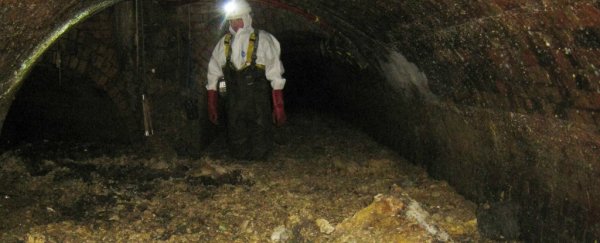People throw all kinds of oily, greasy, messy stuff down the drain at home. Now, some of that sewage is taking its revenge above-ground.
Hunks of a massive London "fatberg" are going on display this Friday at the Museum of London.
The stomach-churning rock-hard mass, which weighed as much as ten double-decker buses underground, took up an area the size of two football fields in the city's aging Victorian-era sewers last fall.
The mess prompted renewed calls for people to stop throwing things other than toilet paper and bodily fluids down the pipes.
Matt Rimmer, Thames Water's head of waste networks, told Reuters that the mix of wet wipes, diapers, cosmetic grease, cooking oil, soaps and other toilet trash can congeal into a hardened form as tough to break up as concrete.
"It's frustrating as these situations are totally avoidable and caused by fat, oil and grease being washed down sinks and wipes flushed down the loo." Rimmer said.
But London loo-goers aren't the only ones suffering from greasy modern-age icebergs of underground filth. Similar fatbergs have recently been unearthed in Australia, Wales, and Baltimore, Maryland.
In New York City, grease accounted for 71 percent of sewer backups city wide in 2016, while debris and trash clogged up another 16 percent of the city's pipes.
Thames Water spent weeks blasting through the clog, which stretched longer than 2 football fields (820 feet). Workers had to break it up with high-powered hoses before it was converted to biofuels.
But they managed to preserve a couple of small, shoebox-sized hunks for the Museum of London, where curator Vyki Sparkes is thrilled to have the world-first exhibit on display.
How to display a fatberg
The only tricky part, Sparkes said, was figuring out how to showcase a disease-inducing fatberg in a way that wouldn't make museum visitors sick.
The toxic chemicals in sewer gas include stinky hydrogen sulfide, and sniffing the chemicals can be deadly.
"In the end we decided air-drying was probably the safest form [of preservation]" Sparkes told Business Insider. "It's less of a splash risk."
The samples, which were carried up through manholes and then dried out and monitored for toxic gases, are already not quite the same as they were in the sewer.
"They used to be a lot wetter and browner and a bit waxy looking, but now they've dried out a lot and are sort of quite crumbly, almost a bit like moon rock," Sparkes said. (If moon rock were made of palm oil, diapers, wet wipes and discarded chocolate wrappers, that is.)
Sparkes said the museum staff has watched the fatberg hatch flies this week. On Tuesday, she saw at least three hanging out in a sealed container.
"We have no idea in the long term what might happen to this," Sparkes said. "There is a risk that it basically turns into a pile of dead flies."
The exhibit, which opens to the public in London on Friday February 9, is free and unticketed.
The fatberg is coming to the Museum of London. Do you dare face it on 9 February? https://t.co/LE7sul7I9K #fatbergiscoming pic.twitter.com/Pj0R1I18cp
— Museum of London (@MuseumofLondon) February 7, 2018
This article was originally published by Business Insider.
More from Business Insider:
